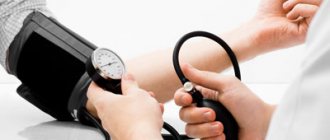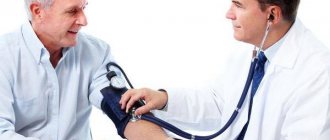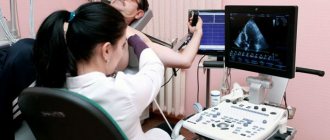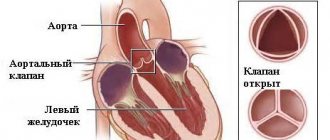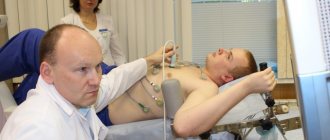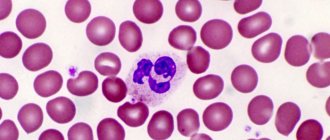What is the pathogenesis associated with?
The pathogenesis of arterial hypertension is associated with dysfunctions of the body, these are:
- increased levels of adrenaline, renin, aldosterone, angiotensin;
- strong inhibition, high excitation in the cerebral cortex;
- tonic contraction of arterioles, resulting in hypertrophy and ischemia (insufficient blood supply) of organs.
The etiopathogenesis of increased blood pressure (BP) begins as a result of psycho-emotional stress. Next, a disorder of lipid-protein metabolism develops, and a stagnant focus of constant excitation of the central nervous system is formed. As a result, arterial spasm occurs and hypertension develops. Arterial hypertension is closely related to the endocrine nature of the pathogenesis.
Causes of arterial hypertension
Arterial hypertension, the etiology of the disease and pathogenesis are not fully understood. It is known that the causes of pathology are associated with disruption of regulatory mechanisms and subsequent functional and organic dysfunctions.
The regulatory mechanisms underlying hypertensive pathogenesis are as follows:
- Hyperadrenergic: associated with an increase in sympathetic tone, the density and sensitivity of adrenergic receptors, and activation of the sympathoadrenal system.
- Sodium volume dependent: associated with fluid retention in the body. Excessive salt intake leads to increased interstitial fluid volume, increased venous return and cardiac output.
- Hyperrenin: increased renin levels with a further increase in angiotensin II, aldosterone.
- Calcium-dependent: accumulation of calcium in vascular smooth muscle.
The next stage after prolonged psycho-emotional stress and the accompanying renal factor is the progression of the atherosclerotic process. Atherosclerosis is a chronic vascular disease accompanied by the accumulation of “bad” cholesterol. Vessels lose elasticity, become more brittle and are unable to fully provide their function. The heart has to forcefully pump out blood so that it circulates in the narrowing vessels. Hypertension develops, and if the disease is not treated, the symptoms will only get worse.
High blood pressure is benign and malignant. This is why it is so important to promptly treat the disease at an early stage and be observed by a cardiologist.
Hereditary pathogenesis and external influences
Primary (essential) arterial hypertension is associated with hereditary predisposition and external influences. A characteristic feature of this etiology is a sustained increase in blood pressure, but the target organs and body systems are not affected.
The etiopathogenesis of this hypertension is:
- hormonal disorders;
- previous salt diet;
- heredity;
- taking vasoconstrictor drugs.
Hereditary pathogenesis includes:
- Kidney diseases in which water-salt metabolism is disrupted. Fluid retention increases the load on the heart muscle and, as a result, increases blood pressure. Possible complications if left untreated are kidney nephritis, a chronic form of kidney disease.
- Neoplasms in the adrenal glands. Dysfunction of aldosterone secretion, which disrupts the water-salt balance, developing hyperaldosteronism.
- Renovascular hypertension is insufficient oxygen saturation of the kidneys by the abdominal aortas. Lack of oxygen leads to vasoconstriction and rapid heartbeat. Typically for smokers, children, and the elderly.
- Taking medications with side effects: antipyretics, glyceric acid, cortisone steroids.
- Pregnancy, especially in the third trimester. Often accompanied by late toxicosis. The blood pressure level reaches 140/90 mm Hg. Art. Indicators above should be a reason for a visit to the doctor and further treatment.
- Pheochromocytoma is a type of adrenal tumor that causes increased adrenaline. This leads to increased heart rate, redirecting blood to the lower extremities. The patient usually has a fever and trembling. The risk of renoparenchymal complications and inflammation of the glomeruli (glomerular nephritis) increases.
Other risk factors
Hereditary predisposition is of great, but not the most decisive, importance. The reasons for the possible development of hypertension are:
- nervous tension;
- excess weight;
- exposure to external factors: work in hazardous industries, increased noise levels, poisoning with harmful gases;
- excessive consumption of salty, fatty foods;
- abuse of strong drinks: coffee, tea, alcohol;
- age-related changes;
- hormonal changes: in adolescents during the period of growth and development, in women - during menopause.
Symptomatic hypertension is a disease associated with a primary disease of organs that affects the disruption of functional systems.
Etiology
The etiology and pathogenesis of hypertension include primary and secondary hypertension. Primary or essential hypertension is an independent disease, while secondary or symptomatic hypertension is a consequence of more serious pathological processes.
The exact causes of hypertension are difficult to determine, but it is possible to identify risk factors that provoke the development of hypertension:
- Constant physical or nervous tension - prolonged stress not only gives rise to arterial hypertension, but also contributes to its active progression, in addition, it can cause such dangerous consequences as stroke and heart attack.
- Genetic predisposition - scientists have proven that the chances of developing hypertension directly depend on how many relatives have this disease.
- Excess weight - keep in mind that every ten kilograms of excess subcutaneous and, especially, visceral fat increases blood pressure by 2-4 mmHg. Art.
- Occupational factors - constant eye strain, exposure to noise or prolonged mental and emotional stress increase blood pressure and lead to the development of the disease.
- Excessively salty food - a person should consume no more than 5 grams of salt in one day; exceeding the dosage increases the risk of developing hypertension.
- Bad habits - frequent drinking of alcohol, smoking, as well as excessive coffee consumption increase blood pressure, in addition to hypertension, the risk of heart attack and stroke increases.
- Age-related changes - hypertension often appears in young men as a result of rapid growth, as well as in women in menopause, when hormonal imbalances occur.
Bad habits – frequent drinking of alcohol and smoking increase blood pressure.
Symptoms of hypertension
Pronounced signs of hypertension appear only in the later stages; the disease may not manifest itself for a long time. The danger of hypertension is that the organs are not sufficiently supplied with oxygen. According to the degree of symptoms, four directions of destructive action are distinguished:
- Impaired functioning of the arteries. In this case, the loss of elasticity is accompanied by the deposition of fatty elements. If such a process occurs in the heart area, angina pectoris (“angina pectoris”) is possible, and intermittent claudication is possible in the lower extremities.
- Thrombosis is an oversaturation of blood with blood clots. A thrombus in the cardiac artery leads to a heart attack, and in the carotid artery it leads to a stroke. The kidneys are affected, hemorrhage and partial loss of vision develop.
- Damage to the brain and heart. A compensatory mechanism is activated, in which the need for oxygen in the brain is compensated by the selection of oxygen from other organs. If there are cholesterol plaques in the vessels, the risk of having a stroke increases significantly. Due to overload, the heart muscle becomes weaker and cannot cope with the blood supply to all organs with oxygen.
- Impaired kidney function and vision. Due to the intensive work of the kidneys, blood filtration worsens, more toxins remain in it, which normally leave the body in the urine. The inflammatory process begins - pyelonephritis. Deterioration of vision appears several years after the onset of hypertension, although all this time the eyes experienced a lack of oxygen and retinal degeneration.
Classification of the disease - diagram
Pathogenesis of hypertension - a diagram of the forms of pathology and the meanings during their development:
- In the mild form – systolic 140-180, diastolic – 90-105;
- In moderate form - systolic 180-210, diastolic - 105-120;
- In advanced forms, systolic is more than 210, diastolic is more than 120.
Stages of hypertension:
- The first stage - blood pressure rises for a short time, quickly returns to normal under favorable conditions;
- The second stage – high blood pressure is already stable, the patient needs constant medication;
- The third stage - complications of arterial hypertension develop, changes occur in the vessels and internal organs - the heart, brain, kidneys.
At the second stage of hypertension, the patient requires constant medication.
There is a slowly progressing hypertensive disease and a rapidly progressing disease; doctors call the second a malignant type.
The onset of the disease can be recognized by the development of initial symptoms; against the background of overwork or stress, the patient may be bothered by:
- Head pain and dizziness, feeling of heaviness;
- Attacks of nausea;
- Frequent tachycardia;
- Feeling restless.
When the disease enters the second stage, symptoms appear more often, their appearance occurs in the form of hypertensive crises. Hypertensive crises are sudden and unexpected attacks of illness.
The pathology at the third stage differs from the first two in terms of damage to internal organs; they manifest themselves in the form of hemorrhages, visual impairment, and kidney diseases. To diagnose arterial hypertension, a conventional tonometer is sufficient.
If elevated blood pressure was observed several times, this may indicate the development of the disease. In order to make an accurate diagnosis, the doctor will prescribe an ultrasound examination of the heart, angiography of the brain vessels, ultrasound of the kidneys, and urine and blood tests are also required.
Classification of hypertension
Possible complications based on the degree of blood pressure increase:
- I degree: blood pressure 140-159/90-99 mm Hg. Art. Low risk factor: about 15% in the next 10 years;
- II degree: blood pressure 160-179/100-109 mm Hg. Art. The presence of 1-2 factors increases the risk of developing diabetes mellitus and other complications by 15-20%;
- III degree – blood pressure above 180/110 mm Hg. Art. The presence of three or more factors: the risk of target organ damage, diabetes mellitus of varying degrees, other complications - by 20-30%.
There is also a high risk of stroke, myocardial infarction, angina pectoris, chronic heart failure, aortic aneurysm dissection, and hemorrhage in the eyes. With a malignant course of arterial hypertension, the risk of a hypertensive crisis increases. The risk of complications is about 30% in the next 10 years.
Other risk factors:
- males from 50 years old, females - from 65;
- bad habits: smoking, alcohol;
- excess weight;
- cholesterol from 6.5 mmol/l.
General symptoms of hypertension:
- headache, especially at night, in the forehead, back of the head, around the entire circumference;
- dizziness;
- nausea, vomiting;
- noise in ears;
- visual disturbances, including the appearance of “spots” before the eyes;
- heart pain;
- facial redness;
- increased anxiety.
Pathogenesis of hypertension
Doctors call pathogenesis the system of occurrence and development of hypertension and any other disease. Hypertension is most often diagnosed in residents of large cities: they are more susceptible to stress and disrupted rhythm of life. Following the doctor's recommendations allows you to reduce the symptoms of the disease and the mortality rate to a minimum.
Pathogenesis of the disease
Researchers believe that hypertension may run in families. The disease manifests itself under unfavorable conditions that cause the pathogenesis of hypertension.
The basis of the pathogenesis of hypertension is damage to peripheral vessels.
They become deformed, and as a result, metabolic regulation is disrupted. This leads to malfunctions of the medulla oblongata and hypothalamus, which causes a significant increase in the production of pressor substances.
The arterioles stop responding to the minute ejections of blood from the heart muscle because the arteries are unable to expand. The pressure level in the internal organs increases. If the pressure in the kidneys has increased, this leads to excessive production of renin.
The hormone enters the blood, where it interacts with angiotensinogen. Renin gradually transforms into the first and second states of angiotensin. The second type is a strong vasoconstrictor.
The combination of processes leads to increased blood pressure.
Etiology of hypertension
The medical term “etiology” means the cause and conditions under which a disease occurs. Etiology and pathogenesis consider both essential and symptomatic hypertension. Primary or essential headache is a separate independent disease. Symptomatic or secondary becomes the result of pathological changes in the human body.
The etiology of hypertension and the pathogenesis of arterial hypertension are inextricably linked. This led to the emergence of the term “etiopathogenesis,” which includes the causes and mechanisms of formation, development and manifestation of the disease.
Doctors identify several main reasons that lead to the development of hypertension:
- Constant physical or emotional stress. Stressful situations provoke the occurrence of arterial hypertension, heart attacks and strokes,
- Presence of the disease in relatives,
- Obesity,
- Increased noise level
- The need to strain your eyesight
- Prolonged mental stress
- Work at night,
- Consuming a lot of salt
- Abuse of alcohol and strong drinks,
- Smoking,
- Menopause in women
- The period of active growth in men,
- Poor diet and high blood cholesterol levels,
- Atherosclerosis,
- Chronic diseases of the kidneys and other organs.
Hypertension Clinic
The clinical picture of the disease is the course of the disease. Different forms of hypertension are accompanied by a certain level of blood pressure.
At the first stage of hypertension, there is a short-term increase in blood pressure (up to 160/99 mmHg), which usually returns to normal on its own. At the second stage of hypertension, a stable and high level of blood pressure is noted (up to 180/109 mmHg).
It is no longer possible to lower your levels without taking medications. The third degree of hypertension (BP over 180 to 110 mm Hg) is characterized by complications, changes in internal organs (heart, kidneys, liver, blood vessels, brain), and decreased vascular tone.
The disease can develop either slowly or rapidly. Doctors equate rapid development with a malignant form. It is more dangerous and difficult to treat.
Clinical manifestation
At an early stage, elevated blood pressure is accompanied by general weakness, fatigue, inability to concentrate for a long time, headache and frequent dizziness. Patients often complain of insomnia. At stage 1, the sympathetic nervous effect on the walls of all vessels of the circulatory system is activated.
The result is a narrowing of the capacitance vessels, allowing a large amount of venous blood to enter the heart. All this is accompanied by an increase in cardiac output. Along with the activation of the SNV, there is an increase in the level of total peripheral resistance in the vessels and spasms in the capacitance vessels.
This already leads to an increase in the volume of circulating blood.
All these factors cause the persistence of elevated blood pressure levels. As a result of a prolonged and regular increase in blood pressure, hypertrophy of SMC arterioles and myocardium increases, and atherosclerosis develops.
This manifests itself in memory deterioration, movement coordination, and vision problems.
Cerebral circulation is impaired, and the severe course of the disease is also accompanied by ischemic and hemorrhagic strokes.
The course of the disease is worsened by tachycardia, intense pulse, and enlargement of the left cardiac ventricle. The danger of tachycardia in heart failure and arrhythmia.
The third stage is characterized by significant damage to internal organs, tissue deformation, disruption or cessation of the functioning of body systems. Patients experience:
- The presence of atherosclerosis,
- The presence of arteriosclerosis, which leads to heart attack, stroke,
- Cardiomyopathy,
- Violation of intraorgan blood supply,
- Cardiac dysfunction
- Acute pulmonary and heart failure, arrhythmia,
- Changes in the brain and thyroid gland of a dystrophic and sclerotic nature.
The effect of kidney function on hypertension
Symptomatic hypertension is most often caused by kidney pathology (chronic glomerulonephritis) or infections of the urinary system.
The process of regulating blood pressure is impossible without normal kidney function. This organ produces the important hormone renin, which is part of the RAAS system (renin-angiotensin-aldosterone system). It is responsible for water-salt metabolism and blood pressure.
Renal artery stenosis triggers the RAAS system. The production of the vasoconstrictor angiotensin II and vascular spasms occur. Impaired blood microcirculation leads to hypertension.
Vital organs receive less nutrients and oxygen, which leads to disruption of their functioning.
Treatment of hypertension
At the first stage, doctors usually recommend a healthy lifestyle. This is enough to prevent the development of the disease. You just need to review the conditions and hours of work and rest, eliminate emotional stress and stressful situations.
Minimizing the causes of hypertension also includes:
- Gradual weight loss
- Reducing the proportion of animal fats in the diet,
- Eating more fresh vegetables and fruits,
- Eating more fish and seafood
- Reducing salt intake,
- To give up smoking,
- Reducing alcohol consumption,
- Regular feasible physical exercise,
- Walks in the open air,
- Long sleep.
The second stage requires taking medications that are prescribed by the doctor based on tests and examination. Additionally, non-drug therapy is prescribed. This includes acupuncture, herbal medicine, electrosleep, massage. In the presence of various syndromes of hypertension, treatment should be aimed at normalizing blood pressure and restoring the functioning of the affected organs.

